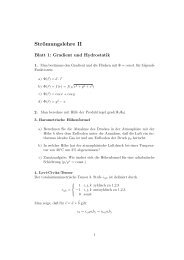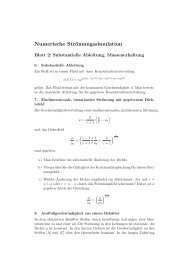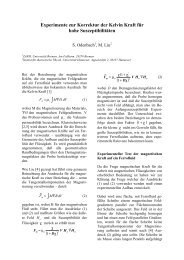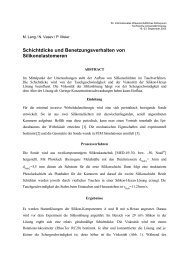Reiterated tension testing of silicone elastomer - TU Ilmenau
Reiterated tension testing of silicone elastomer - TU Ilmenau
Reiterated tension testing of silicone elastomer - TU Ilmenau
You also want an ePaper? Increase the reach of your titles
YUMPU automatically turns print PDFs into web optimized ePapers that Google loves.
372<br />
<strong>Reiterated</strong> <strong>tension</strong> <strong>testing</strong> <strong>of</strong> <strong>silicone</strong><br />
<strong>elastomer</strong><br />
P. Meier*, M. Lang and S. Oberthür<br />
A peristaltically actuated device, PADeMIS, composed <strong>of</strong> <strong>silicone</strong> rubber (SR) is under<br />
development for use in minimally invasive surgery. During locomotion, the device will be subject<br />
to a few thousand load changes involving varying, sometimes high, strains. The design is being<br />
optimised by finite element analysis, for which a constitutive law for the mechanical behaviour <strong>of</strong><br />
<strong>silicone</strong> rubber is required. Uniaxial and biaxial <strong>tension</strong> tests have been performed on specimens<br />
<strong>of</strong> used silicon rubber. Synchronous fitting <strong>of</strong> uniaxial and biaxial tensile data gives significantly<br />
better results than using uniaxial or biaxial results alone to derive constitutive laws. The<br />
mechanical properties <strong>of</strong> SR were found to change from loading to loading up to few thousand<br />
cycles. Hence, simulating the deformation <strong>of</strong> SR structures is problematic. Furthermore, variability<br />
was observed between batches <strong>of</strong> SR.<br />
Keywords: PADeMIS, Artificial worm, Uniaxial <strong>tension</strong>, Lifetime<br />
Introduction<br />
A Peristaltically Actuated Device for Minimal Invasive<br />
Surgery (PADeMIS) is being developed at the Technical<br />
University <strong>of</strong> <strong>Ilmenau</strong>. The device will move actively like<br />
an earthworm carrying a hollow tube inside its back.<br />
The tube and the active part <strong>of</strong> the device provide a<br />
channel in which endoscopic tools can be inserted for<br />
use in invasive surgery. The first application <strong>of</strong><br />
PADeMIS is in minimally invasive spine surgery. The<br />
device will be inserted into the spinal canal at the os<br />
sacrum and moved cranially between the vertebral<br />
bodies and the dura mater spinalis. Therefore,<br />
PADeMIS has to be designed to fit the spinal canal:<br />
the outer diameter <strong>of</strong> PADeMIS must be adjustable<br />
from 4 to 10 mm with a minimum inner diameter <strong>of</strong><br />
2 mm for the endoscopic instruments. The device will be<br />
made <strong>of</strong> <strong>silicone</strong> rubber and will consist <strong>of</strong> ‘worm’<br />
segments, each made <strong>of</strong> at least two layers <strong>of</strong> <strong>silicone</strong><br />
enclosing pads. The pads <strong>of</strong> serially arranged segments<br />
will be filled periodically with fluid, thus producing a<br />
peristaltic locomotion (Fig 1). The design <strong>of</strong> a single<br />
segment, shown in Fig. 2, is being optimised by Finite<br />
Element Analysis (FEA) for which a constitutive law as<br />
input property is essential. The loading case <strong>of</strong> the<br />
deformed pads will be approximately biaxial. On the<br />
other hand, uniaxial <strong>tension</strong> tests are generally much<br />
easier and less time-consuming to perform. However, in<br />
order to gain permission for medical use, many longterm<br />
experiments have to be carried out to examine<br />
mechanical fatigue and stress-s<strong>of</strong>tening 1 .<br />
The aim <strong>of</strong> this paper is to study whether a<br />
constitutive law (Mooney–Rivlin law) fitted to uniaxial<br />
Technical University <strong>of</strong> <strong>Ilmenau</strong>, Faculty <strong>of</strong> Mechanical Engineering,<br />
98684 <strong>Ilmenau</strong>, Germany<br />
*Corresponding author, email petra.meier@tu-ilmenau.de<br />
<strong>tension</strong> tests can be used to describe biaxial tests or,<br />
more generally, whether fitting <strong>of</strong> a constitutive law to<br />
one specific loading case leads to a reliable prediction<br />
<strong>of</strong> deformations under other loading conditions.<br />
Furthermore, a simultaneous fit <strong>of</strong> uniaxial and<br />
equibiaxial experimental data is presented. Beyond this,<br />
results <strong>of</strong> some reiterative <strong>tension</strong> tests are presented.<br />
Experimental<br />
The segments <strong>of</strong> PADeMIS are filled periodically with<br />
fluid to produce the peristaltic locomotion. This results<br />
in nearly equibiaxial stress in the <strong>silicone</strong> membrane<br />
(Fig. 2). Therefore, the constitutive law for the FEA<br />
optimization <strong>of</strong> the design should be evaluated by<br />
equibiaxial <strong>tension</strong> tests. The disadvantages <strong>of</strong> the<br />
equibiaxial <strong>tension</strong> tests are intense consumption <strong>of</strong><br />
time and manpower. Hence, for stability tests and<br />
investigations <strong>of</strong> stress-s<strong>of</strong>tening 1 over a long period <strong>of</strong><br />
time, uniaxial <strong>tension</strong> tests are more convenient.<br />
Silicone rubber samples<br />
The samples were produced from the liquid injection<br />
molding <strong>silicone</strong> <strong>elastomer</strong> MED-49xx from NUSIL<br />
distributed by Polytec. The xx indicates the shore<br />
hardness <strong>of</strong> the <strong>silicone</strong> rubber adjusted with silica filler<br />
by the manufacturer. In this paper, results from<br />
experiments performed with MED-4930 and MED-<br />
4950 are shown. The two components are mixed steadily<br />
in a 25% hexane solution. Then they are cast in moulds<br />
(120 mm6120 mm or 170 mm6170 mm) and degassed<br />
for more than 30 h. The next step is the curing <strong>of</strong> the<br />
<strong>silicone</strong> rubber. The thickness <strong>of</strong> the sheets was<br />
measured with a layer thickness measurement<br />
Dualscope made by Fischer. The used layers had a<br />
thickness <strong>of</strong> 500–900 mm and the standard deviation <strong>of</strong> a<br />
ß 2005 Institute <strong>of</strong> Materials, Minerals and Mining<br />
Published by Maney on behalf <strong>of</strong> the Institute<br />
Received 13 September 2005; accepted 12 October 2005<br />
DOI 10.1179/174328905X59737 Plastics, Rubber and Composites 2005 VOL 34 NO 8
1 Schematic view <strong>of</strong> PADeMIS with serial arrangement <strong>of</strong><br />
two filled and four unfilled segments<br />
test sample was less then 10%. For details <strong>of</strong> the setup<br />
and the evaluation see Ref. 2.<br />
Equibiaxial <strong>tension</strong> test<br />
The equibiaxial stress can be measured by inflating a<br />
thin silicon sheet as described by Rivlin and Saunders. 3<br />
The silicon test sample is fixed to an aluminium plate by<br />
an aluminium ring <strong>of</strong> diameter 60 mm and 9 points are<br />
marked. In the middle <strong>of</strong> the aluminium plate, a pressure<br />
supply and a connection for a pressure sensor are<br />
included. Then the aluminium plate with the <strong>silicone</strong><br />
sheet is mounted at a three axes positioning unit made<br />
by ISEL. On the vertical axis, a tip is fixed. The positions<br />
<strong>of</strong> the markers can be measured during deformation due<br />
to the increasing pressure by aligning this tip with the<br />
crossings <strong>of</strong> the marker lines.<br />
Uniaxial <strong>tension</strong> test<br />
For the uniaxial <strong>tension</strong> test, the <strong>silicone</strong> rubber sheet is cut<br />
into pieces 80 mm65 mm. A 20 mm long region is marked<br />
around the centre The sample is fixed in clamps and<br />
attached to the test stand. Two test stands are used. The<br />
samples for the synchronous fitting are loaded with different<br />
weights and the resulting length is measured. The samples<br />
for the repeated <strong>tension</strong> tests are stretched by a stepping<br />
motor at 10 mm s –1 and the resulting force is measured.<br />
Constitutive law: theory<br />
To perform FEA simulations <strong>of</strong> the design <strong>of</strong><br />
PADeMIS, a constitutive law <strong>of</strong> the <strong>silicone</strong> rubber is<br />
2 FEA <strong>of</strong> the deformation <strong>of</strong> one segment <strong>of</strong> PADeMIS<br />
needed as input parameter. A well known constitutive<br />
law for rubber-like materials is the extended Mooney–<br />
Rivlin law, which is based on polynomials 4,5<br />
W~ Xm<br />
izk~1<br />
aik(I1{3) i (I2{3) k z 1<br />
2 k(I3{1) (1)<br />
where W 5 strain energy density, I 1,I 2,I 3 5 invariants<br />
<strong>of</strong> the deformation tensor, k 5bulk modulus, m5order<br />
<strong>of</strong> model and a ik 5 the Mooney–Rivlin constants describing<br />
the material.<br />
Fitting procedure<br />
The experimental data are fitted with a LabVIEW<br />
program. A modified version <strong>of</strong> the LabVIEW<br />
Levenberg–Marquardt x 2 minimization subroutine from<br />
National Instruments Corporation is used. (For programming<br />
the Levenberg–Marquardt method, see<br />
Ref. 6).<br />
The property x 2 describing the distance between the<br />
fitted curve and the experimental value is defined as<br />
x 2 ~ Xn<br />
sfitðl,aikÞ{smeas dsmeas<br />
s fit(l,a ik) 5 calculated constitutive law derived from<br />
equation (1), smeas 5 stress from measured, dsmeas 5<br />
experimental errors and n 5 number <strong>of</strong> experimental<br />
results. In addition, s fit(l,a ik z da ik) and s fit(l,a ik - da ik)<br />
are calculated to get an impression <strong>of</strong> the errors <strong>of</strong> the<br />
fitting process.<br />
For simultaneous fitting, the LabVIEW Levenberg–<br />
Marquardt x 2 minimization subroutine is modified:<br />
x 2 ~x 2 unizx2bi (3)<br />
where x 2 uni 5 x 2 <strong>of</strong> the uniaxial fitting procedure and<br />
x 2 bi 5 x 2 <strong>of</strong> the biaxial fitting procedure as calculated by<br />
equation (2).<br />
Results<br />
Meier et al. <strong>Reiterated</strong> <strong>tension</strong> <strong>testing</strong> <strong>of</strong> <strong>silicone</strong> <strong>elastomer</strong><br />
3 Experimental equibiaxial <strong>tension</strong> test for <strong>silicone</strong> rubber<br />
MED-4930 and MED-4950<br />
First <strong>tension</strong> test<br />
Equibiaxial <strong>tension</strong> test<br />
In Fig 3, the measured stress–stretch dependency for<br />
equibiaxial <strong>tension</strong> <strong>of</strong> the <strong>silicone</strong> rubbers MED-4930<br />
and MED-4950 and the fitted stress–stretch relations are<br />
shown.<br />
2<br />
Plastics, Rubber and Composites 2005 VOL 34 NO 8 373<br />
(2)
Meier et al. <strong>Reiterated</strong> <strong>tension</strong> <strong>testing</strong> <strong>of</strong> <strong>silicone</strong> <strong>elastomer</strong><br />
4 Experimental data and fits <strong>of</strong> the uniaxial <strong>tension</strong> tests<br />
for <strong>silicone</strong> rubber MED-4950<br />
5 Experimental data and fits <strong>of</strong> the uniaxial <strong>tension</strong> tests<br />
for <strong>silicone</strong> rubber MED-4930<br />
As can be seen, the stresses and stretches in direction 1<br />
and 2 are identical within a 10% margin. Thus, the<br />
reproducibility <strong>of</strong> measurements <strong>of</strong> different samples is<br />
very good. The experimental results can be sufficiently<br />
approximated with fitting methods. The values <strong>of</strong> the<br />
fitted parameters can be seen in Table 1. There was no<br />
acceptable fitting result with parameters a 20 ? 0.<br />
Uniaxial <strong>tension</strong> test<br />
The experimental data <strong>of</strong> the uniaxial <strong>tension</strong> tests <strong>of</strong><br />
<strong>silicone</strong> rubber MED-4950 and MED-4930 is shown in<br />
Figs. 4 and 5, respectively. For uniaxial <strong>tension</strong> <strong>of</strong><br />
MED-4950, two curves are shown. For both materials,<br />
Table 1 Mooney–Rivlin parameters <strong>of</strong> <strong>silicone</strong> rubber MED-4930 and MED-4950<br />
6 Fitted constitutive law for equibiaxial and uniaxial <strong>tension</strong><br />
tests <strong>of</strong> <strong>silicone</strong> rubber MED-4950<br />
the fitted stress–stretch characteristics closely match the<br />
tensile strength specified in the data sheet <strong>of</strong> the<br />
manufacturer.<br />
With regard to x 2 and da 01 / a 01 and da 20 / a 20, the fit 2<br />
<strong>of</strong> material MED-4950 is much worse than fit 1. For<br />
both materials, values <strong>of</strong> the parameters a 01 could not be<br />
found. Thus, fitting <strong>of</strong> uniaxial <strong>tension</strong> tests result in<br />
uncertainties for the parameters a0k. The values <strong>of</strong> the<br />
fitted parameters can be seen in Table 1.<br />
Optimisation <strong>of</strong> the constitutive law to equibiaxial and<br />
uniaxial <strong>tension</strong> tests<br />
The fitted constitutive laws are used to calculate a stress–<br />
stretch characteristic to predict the other loading case.<br />
The calculated stress– stretch relations for biaxial and<br />
uniaxial loading for <strong>silicone</strong> rubber MED-4950 and<br />
MED-4930 are shown in Figs. 6 and 7, respectively. In<br />
the MED-4950 biaxial loading case the errors between<br />
the stress–stretch characteristics calculated from the<br />
Parameters a10* da10* a01* da01* a20* da20* x 2<br />
MED-4950<br />
Biaxial fit {<br />
Uniaxial fit 1<br />
503<br />
497<br />
12<br />
6<br />
13 1<br />
0<br />
73 46<br />
. 9 0 . Uniaxial fit 2 484 19 134 27 0<br />
2 718 217<br />
. 5 0 . Simultaneous bi- and uniaxial fit 493 5 10 1 0<br />
3 1003 216<br />
. 9 0 . 2 800 264<br />
MED-4930<br />
Biaxial fit 144 3 15 0 . Uniaxial fit 245 6<br />
5<br />
2 0<br />
283 58<br />
. Simultaneous bi- and uniaxial fit 192 2 1<br />
1 87 432<br />
. 3 0 . 4 3 0 . 05 544 492<br />
*kPa<br />
{ 2<br />
Unlisted parameters are equal to zero. For explanation <strong>of</strong> x see section ‘Silicone rubber samples’ and Ref. 2; n is the degree <strong>of</strong><br />
freedom <strong>of</strong> the fit.<br />
374 Plastics, Rubber and Composites 2005 VOL 34 NO 8<br />
n
7 Fitted constitutive law for equibiaxial and uniaxial <strong>tension</strong><br />
tests <strong>of</strong> <strong>silicone</strong> rubber MED-4930<br />
parameters <strong>of</strong> fit 2 from the uniaxial data and the<br />
experimental data are enormous. Also, a constitutive<br />
law fitted to the biaxial loading case cannot estimate the<br />
MED-4930 uniaxial data. From Table 1, it can be seen<br />
that a constitutive law for the <strong>silicone</strong> rubbers MED-<br />
4950 and MED-4930 needs (at least) the parameters a 10,<br />
a 01 and a 20, but fits to one loading case give no satisfying<br />
results for all three parameters.<br />
The stress–stretch relations fitted to biaxial and uniaxial<br />
simultaneously (according to equation (3)) are also shown<br />
in Figs. 6 and 7 respectively. Thus, the Mooney–Rivlin<br />
approach <strong>of</strong> the constitutive law is able to describe the<br />
biaxial and uniaxial loading case simultaneously. The<br />
parameters a ik <strong>of</strong> <strong>silicone</strong> rubber MED-4930 and MED-<br />
4950 are listed in Table 1. It is possible to find the three<br />
parameters a 10, a 01, and a 20 with small errors and<br />
acceptable x 2 via the simultaneous fit. The validity <strong>of</strong> the<br />
resulting constitutive law for other loading cases can be<br />
estimated by calculating the stress from the constitutive<br />
law and considering the orders <strong>of</strong> stretch l for each<br />
parameter <strong>of</strong> the constitutive law. The parameters belonging<br />
to terms with high orders <strong>of</strong> stretch l for the simulated<br />
load case should also belong to terms with high orders <strong>of</strong><br />
stretch l for the experimental setup, too.<br />
<strong>Reiterated</strong> <strong>tension</strong> tests<br />
For filled rubber, stress-s<strong>of</strong>tening due to rearrangement <strong>of</strong><br />
the filler particle is well known. PADeMIS will undergo a<br />
few thousand cycles during a surgery. Thus, long term<br />
load cycles are performed to characterise the material.<br />
Tensions test with increasing loading<br />
Samples are loaded till the stretch l 1 is reached, then<br />
relaxed and subsequently loaded till stretch l 2.l 1 is<br />
Meier et al. <strong>Reiterated</strong> <strong>tension</strong> <strong>testing</strong> <strong>of</strong> <strong>silicone</strong> <strong>elastomer</strong><br />
8 Successive uniaxial <strong>tension</strong> tests <strong>of</strong> MED-4950 to<br />
increasing stretches<br />
reached. Afterwards, loading till stretch l3.l2 is performed.<br />
During the first discharging, the samples show a large<br />
hysteresis and, during recharging, the samples follow<br />
approximately the discharging curve up to the previous<br />
maximum load. Then the stress–stretch relation switches<br />
to the relation <strong>of</strong> undamaged samples. This behaviour<br />
conforms to the stress-s<strong>of</strong>tening described by Mullins 1 .<br />
Stress–stretch relations <strong>of</strong> typical samples <strong>of</strong> MED-4950<br />
are shown in Figs. 8 and 9 for uniaxial <strong>tension</strong> and<br />
equibiaxial <strong>tension</strong> tests, respectively.<br />
Successive <strong>tension</strong> tests to same load<br />
The segments <strong>of</strong> PADeMIS will be filled with volume<br />
control. Observing the resulting pressure could give<br />
information about the environment and contact area<br />
between PADeMIS and surrounding tissue, assuming a<br />
constant stress–stretch relation for the material preloaded<br />
at least to the used load. Thus, successive <strong>tension</strong><br />
tests to the same length are performed. Unfortunately,<br />
equibiaxial <strong>tension</strong> tests are very time consuming, so<br />
only results for uniaxial <strong>tension</strong> are presented.<br />
Decreasing maximal stress<br />
Figure 10 shows the stress–stretch relations for a sample<br />
loaded 4000 times to a stretch l
Meier et al. <strong>Reiterated</strong> <strong>tension</strong> <strong>testing</strong> <strong>of</strong> <strong>silicone</strong> <strong>elastomer</strong><br />
10 Decreasing maximal stress during successive uniaxial<br />
<strong>tension</strong> tests <strong>of</strong> MED-4950 to same stretch<br />
is approximately an exponential function, but the<br />
sample fails before a steady state is reached.<br />
Plastic deformation<br />
Usually SR is described as a hyperelastic material, but,<br />
as shown in Fig. 11, there is a significant plastic<br />
deformation <strong>of</strong> the sample. The plastic deformation<br />
can make up to 50% <strong>of</strong> the initial length <strong>of</strong> the sample<br />
for large stretches. The first load cycle causes quite a<br />
large plastic deformation, whereas, for successive load<br />
cycles, the plastic deformation increases smoothly. The<br />
amount <strong>of</strong> plastic deformation depends on the amount<br />
<strong>of</strong> maximum stretch.<br />
Lifetime<br />
To estimate the range and endurance <strong>of</strong> the artificial<br />
worm PADeMIS successive <strong>tension</strong> tests up to the<br />
failure <strong>of</strong> the SR were performed. For MED-4950,<br />
the results are shown in Fig. 12. For large stretches,<br />
l.7, the life cycle is rather short and only a few load<br />
cycles can be performed. For smaller stretches, the life<br />
cycle increases up to a few thousand load cycles for<br />
11 Progress <strong>of</strong> plastic deformation during successive<br />
uniaxial <strong>tension</strong> tests <strong>of</strong> MED-4950 to the same<br />
stretch<br />
376 Plastics, Rubber and Composites 2005 VOL 34 NO 8<br />
12 Number <strong>of</strong> iterations <strong>of</strong> uniaxial <strong>tension</strong> tests <strong>of</strong><br />
MED-4950 to same stretch l till failure <strong>of</strong> sample<br />
samples stretched by a factor <strong>of</strong> 3 or less. Unlike<br />
Hookean materials such as steel, which can be loaded, to<br />
small strains, for a few million load cycles without<br />
failure, SR seems to accumulate failures from previous<br />
stretch cycles. This means the SR seems to remember<br />
previous stretches. So the integral <strong>of</strong> the strain energy<br />
density W over the time <strong>of</strong> total load t should be<br />
considered. Unfortunately, this is experimentally difficult.<br />
Therefore the sum <strong>of</strong> the strain energy density W<br />
over the number <strong>of</strong> <strong>tension</strong> tests N<br />
ð<br />
Wdt (4)<br />
and the integral <strong>of</strong> the strain energy density W over<br />
stretch l<br />
X<br />
N<br />
WðlmaxÞ (5)<br />
are calculated as a rough approximation (Fig. 13). As<br />
parameters for the strain energy density W values, fitted<br />
stretched samples are used. But both approximations<br />
lead to a unsatisfactory prediction <strong>of</strong> the sample life.<br />
Varying quality <strong>of</strong> batches<br />
Even though SR has a nonlinear complex stress–stretch<br />
relation, the manufacturer indicates only a tensile<br />
13 Integral <strong>of</strong> strain energy density and sum over strain<br />
energy density in dependency <strong>of</strong> maximal stretch and<br />
number <strong>of</strong> iteration
14 Uniaxial <strong>tension</strong> tests <strong>of</strong> MED-4950 for samples prepared<br />
from different batches <strong>of</strong> SR<br />
strength and a maximal elongation. On the contrary, an<br />
expiry date <strong>of</strong> a few months is guaranteed. Because <strong>of</strong><br />
this, the stress–stretch relation <strong>of</strong> samples prepared from<br />
different batches are compared in Fig. 14 The differences<br />
between the batches are significantly higher than<br />
the variance within a batch. When obtaining SR for<br />
production <strong>of</strong> PADeMIS, the manufacturer has to be<br />
asked for the same or a similar batch.<br />
Conclusions<br />
The experiments presented in this paper were performed<br />
as the basis for simulations <strong>of</strong> structures made <strong>of</strong> silicon<br />
rubber. On the one hand, it is shown that fitting<br />
experimental data <strong>of</strong> one loading case can lead to wrong<br />
parameters in the Mooney–Rivlin law and therefore to<br />
wrong predictions for other loading cases or complex<br />
deformation states. On the other hand, for <strong>silicone</strong><br />
rubber, a set <strong>of</strong> Mooney–Rivlin parameters describing<br />
uniaxial and equibiaxial experiments simultaneously<br />
were found. Unfortunately, SR shows both Mullins<br />
effects for load cycles to the same length and stresss<strong>of</strong>tening<br />
for load cycles to the same length for<br />
reiterative <strong>tension</strong> tests. Therefore, a steady-state constitutive<br />
law cannot be found. Simulations <strong>of</strong> a<br />
structure, which has to perform a few thousand load<br />
cycles, is either linked with rough approximations or<br />
extensive time consumption. The relative short lifetime<br />
<strong>of</strong> SR should be considered and there is also a rather<br />
high variance for different batches <strong>of</strong> the same material<br />
delivered.<br />
Acknowledgment<br />
Many thanks are due to the students Samer Khader and<br />
Andreas Mu¨nch for performing thousands <strong>of</strong> <strong>tension</strong><br />
tests and to Mike Stubenrauch for correction <strong>of</strong> the<br />
manuscript. Furthermore, we would like to thank the<br />
TKM (Ministry <strong>of</strong> Education <strong>of</strong> Thuringia) for financial<br />
support <strong>of</strong> the NachwuchsgruppePeristaltische Sonde<br />
Peristaltic Device.<br />
References<br />
Meier et al. <strong>Reiterated</strong> <strong>tension</strong> <strong>testing</strong> <strong>of</strong> <strong>silicone</strong> <strong>elastomer</strong><br />
1. L. Mullins: Rubber Chem.Technol., 1969, 42, 339–362.<br />
2. P. Meier, S. Khader, R. Preuss, J. Dietrich, and D. Voges:<br />
in ‘Constitutive Models for Rubber III’, J. Busfield and A. Muhr<br />
(eds), p. 99–106; 2003, Lisse, The Netherlands, Swets &<br />
Zeitlinger.<br />
3. R. S. Rivlin and D. W. Saunders: Phil. Trans. Roy. Soc, 1951,<br />
A243, 251.<br />
4. M. Mooney: J. Appl. Phys., 1940, 11, 582–593.<br />
5. R. S. Rivlin: ‘Forty years <strong>of</strong> non-linear continuum mechanics’,<br />
Proc. IX Int. Congress on Rheology, Mexico, 1984, 1–29.<br />
6. W. H. Press, S. A. Teukolsky, W. T. Vetterling and B. P. Flannery:<br />
‘Numerical recipes in C’; 2002, Cambridge, UK, Cambridge<br />
University Press.<br />
Plastics, Rubber and Composites 2005 VOL 34 NO 8 377







